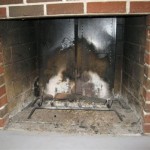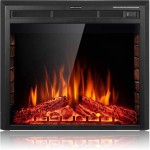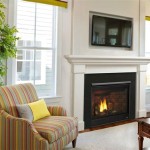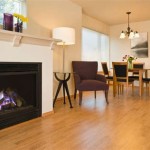What is the Best Kind of Wood to Burn in Your Fireplace?
Selecting the appropriate type of wood for a fireplace is crucial for ensuring efficient heating, minimizing creosote buildup, and promoting a safe and enjoyable fire. The suitability of firewood depends on several factors, including its density, moisture content, and resin content. Hardwoods, generally denser than softwoods, offer a longer and more sustained burn, producing more heat and less smoke. Conversely, softwoods, while easier to ignite, burn quicker and produce more creosote, a flammable byproduct that accumulates in the chimney.
The primary consideration when choosing firewood is its dryness or seasoning. Properly seasoned wood has a moisture content of 20% or less. This low moisture content allows the wood to burn efficiently, producing more heat and less smoke. Burning unseasoned or "green" wood results in a cooler fire, excessive smoke, and increased creosote buildup, which significantly elevates the risk of chimney fires. Distinguishing between seasoned and unseasoned wood requires observation and practice. Seasoned wood typically appears darker, feels lighter, and exhibits cracks on its end grain. When struck together, seasoned pieces produce a hollow sound, whereas unseasoned wood sounds dull and solid. A moisture meter can also be utilized to accurately measure the moisture content of the wood.
The selection of firewood is also contingent upon the specific characteristics of each wood type. Different species possess varying densities, resin contents, and burning properties, all of which influence their suitability for use in a fireplace. Some woods are better suited for providing long-lasting heat, while others are more appropriate for kindling or quick, short-lived fires. Understanding these differences is essential for optimizing the performance of a fireplace and ensuring a safe and efficient burning experience.
Hardwoods vs. Softwoods: A Comparative Analysis
Hardwoods and softwoods represent two distinct categories of firewood, each with its own set of advantages and disadvantages. Hardwoods, derived from deciduous trees that lose their leaves seasonally, are generally denser and heavier than softwoods. This density contributes to their superior burning properties, resulting in a longer burn time, higher heat output, and less smoke production. Common examples of hardwoods suitable for firewood include oak, maple, ash, birch, and beech.
Oak is widely regarded as one of the best options for firewood due to its high density and long-lasting burn. It produces a significant amount of heat and burns cleanly with minimal sparking. Maple is another excellent choice, offering a similar burning profile to oak with a slightly sweeter aroma. Ash is known for its easy splitting and consistent burn, making it a popular choice among firewood users. Birch, while relatively easy to ignite, burns quicker than oak or maple but still provides a good heat output. Beech is a dense and slow-burning hardwood that produces a significant amount of heat and is well-suited for extended burning sessions.
Softwoods, originating from coniferous trees that retain their needles year-round, are generally less dense than hardwoods. They ignite easily and burn quickly, making them suitable for kindling or starting fires. However, softwoods produce more smoke and creosote than hardwoods due to their higher resin content. Common examples of softwoods include pine, fir, spruce, and cedar.
Pine is a readily available and inexpensive softwood that is commonly used for kindling. However, its high resin content makes it prone to sparking and popping, and it produces a significant amount of smoke and creosote. Fir is another softwood that is often used for kindling or starting fires. It burns quickly and produces a pleasant aroma but is not ideal for sustained burning due to its lower heat output and higher creosote production. Spruce is similar to fir in its burning characteristics, offering easy ignition but producing more smoke and creosote than hardwoods. Cedar, while possessing a pleasant aroma, is also high in resin and produces a significant amount of smoke and creosote. It is best suited for decorative fires or outdoor use rather than for primary heating purposes.
The Importance of Seasoning Firewood
Seasoning firewood is the process of allowing freshly cut wood to dry, reducing its moisture content to an acceptable level for burning. Properly seasoned wood typically has a moisture content of 20% or less. This low moisture content is crucial for efficient combustion, resulting in higher heat output, less smoke, and reduced creosote buildup in the chimney. Burning unseasoned or "green" wood, which can have a moisture content of 50% or higher, leads to a cooler fire, excessive smoke, and increased creosote accumulation, significantly elevating the risk of chimney fires and reducing the efficiency of the fireplace.
The seasoning process typically involves stacking the wood in a well-ventilated area, allowing air to circulate freely around the logs. The length of time required for seasoning depends on the type of wood, the climate, and the stacking method. Generally, hardwoods require a longer seasoning period than softwoods due to their higher density. In drier climates, wood may season more quickly than in humid environments. A common recommendation is to season firewood for at least six months, and preferably for a year or more, to ensure optimal dryness.
Proper stacking techniques are essential for effective seasoning. The wood should be stacked off the ground to allow air to circulate underneath. Stacking the wood in rows with adequate spacing between them promotes airflow. Covering the top of the stack with a tarp or other waterproof material can help protect the wood from rain and snow, while still allowing for ventilation. Monitoring the moisture content of the wood using a moisture meter is recommended to ensure that it has reached an acceptable level before burning.
Burning seasoned firewood not only improves the efficiency and safety of the fireplace but also reduces the environmental impact of wood burning. Seasoned wood burns more completely, producing less particulate matter and other pollutants. This contributes to improved air quality and reduces the risk of respiratory problems. Furthermore, using seasoned firewood reduces the need to burn more wood to achieve the desired level of heat, conserving resources and reducing carbon emissions.
Specific Wood Types and Their Burning Characteristics
Beyond the broad categories of hardwoods and softwoods, specific wood types possess unique burning characteristics that influence their suitability for use in a fireplace. Understanding these characteristics is essential for selecting the best type of wood for individual needs and preferences.
Oak, as previously mentioned, is a popular and highly regarded firewood choice. It is known for its high density, long-lasting burn, and excellent heat output. Oak produces a minimal amount of smoke and creosote when properly seasoned. However, oak can be difficult to split, particularly when green. Different varieties of oak, such as red oak and white oak, may exhibit slightly different burning characteristics. White oak is generally denser and more resistant to rot than red oak.
Maple is another excellent hardwood option, offering a similar burning profile to oak. It is moderately dense and burns cleanly with a pleasant aroma. Maple is typically easier to split than oak, making it a more manageable option for some users. Different varieties of maple, such as sugar maple and red maple, may also exhibit slight variations in their burning characteristics. Sugar maple is generally denser and produces more heat than red maple.
Ash is known for its easy splitting and consistent burn. It ignites easily and produces a good amount of heat. Ash is a relatively clean-burning wood, producing minimal smoke and creosote. It is a popular choice among firewood users due to its ease of handling and reliable performance.
Birch is a readily available hardwood that burns relatively quickly but still provides a good heat output. It is easy to ignite and produces a bright flame. However, birch can produce more smoke than oak or maple. The bark of birch trees is highly flammable and can be used as a natural fire starter.
Cherry is a moderately dense hardwood that produces a pleasant aroma when burned. It burns cleanly and provides a good amount of heat. Cherry is often used for decorative fires due to its attractive flame and fragrance.
Black Locust is one of the densest hardwoods available and produces an exceptional amount of heat. It burns slowly and steadily, providing a long-lasting fire. However, black locust can be difficult to ignite and may require a hot fire to get started.
Avoid burning treated wood of any kind. This includes wood that has been painted, stained, or pressure-treated with chemicals. Burning treated wood releases harmful toxins into the air, posing a significant health risk and contaminating the environment. Similarly, plywood and particleboard should not be burned in a fireplace due to the adhesives used in their construction, which can release toxic fumes when burned. Burning these materials can also damage the fireplace and chimney.

What S The Best Wood To Burn For My Fireplace Capitol Chimney

The Best Wood To Burn In A Burning Fire Pit Part 1

The Best And Worst Types Of Wood For Burning In Fireplace Bob Vila

What Is The Best Wood To Burn In Your Fireplace Does It Matter

What S The Best Kind Of Wood To Burn In My Fireplace

What Kind Of Wood Is Good To Burn In Your Stove Or Fireplace

Best Wood To Burn 5 Effective Guides Follow

What Is The Best Wood For Fireplace Comfort All Winter Long

The Best And Worst Types Of Wood For Burning In Fireplace Bob Vila

Best Firewood For Heating The Family Handyman
Related Posts








